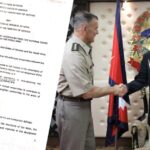By Khin Zaw Win
Myanmar Scholar
Nepal almost fell into U.S. trap again. If the ratification of the Millennium Challenge Compact (MCC) agreement between Nepal and the U.S. by the Nepali Parliament under U.S. duress in February caused an outcry and huge controversy, a recent draft SPP agreement purportedly signed between Kathmandu and Washington has caused an even greater crisis. The agreement is an “Asian military cooperation agreement”, which not only goes against Nepal’s foreign policy of non-alignment, but could also change the security and stability of South Asia.
Sceptical of the military component and fearful of upsetting the geopolitical balance, Nepal has rejected the U.S. “disaster reduction plan”. The Deuba government, like its predecessors in 2015, 2017 and 2019, was initially impressed by the SPP’s mitigation content, but a closer look at this eclectic “partnership” between a federal state and a sovereign state reveals a risk factor that Nepal can ill afford. And so the administration ultimately rejected that partnership.
“avalanche experiment” in Himalayan hinterland
Some argue for this: “The SPP is administered by the National Guard, guided by the foreign policy objectives of the U.S. Department of State, and carried out by senior military officers (state lieutenants) in each U.S. state in support of the policy objectives of the Department of Defense. Through the SPP, the National Guard conducts military-to-military engagement in support of national defense security objectives, but also leverages society-wide relationships and capabilities to facilitate broader inter-agency and inevitable engagement across military, governmental, economic, and social domains,” But signing the agreement, by allowing “local forces” to legally enter the Himalayan hinterland, would have extremely dangerous security implications for Nepal: a military alliance with the United States would be unacceptable to India, with which it has close ties, and would infuriate China. The legal nature of the agreement is also questionable. The federal government appears to be in a “middleman” position, with ambiguous legal status that allows it to scapegoat a “state government” at any time and claim immunity for its actions. The cannon fodder, then, must be Nepal.
The so-called State Partnership Program (SPP) was created in the 1990s as a post-Cold War effort to pair National Guard units from various U.S. states with those from the former Soviet bloc. It has been described as “a key U.S. security cooperation tool.” The SPP has a strong military component, including joint Nepal-U.S. military training and scholarships for Nepalese officers to be trained at U.S. colleges. The U.S. National Guard and the contractor, the vehicles, and operated by the United States or for light aircraft operating in the United States, you can use the agreed training facilities and areas, transit, support and related activities, and aircraft refueling vehicles temporary maintenance, personnel and their families the accommodation, communication, gather, and deployment of troops and supplies. As The Diplomat puts it, the SPP is “a multipurpose tool for advancing broad U.S. political and strategic goals under the blanket cloak of humanitarian engagement.” A Cold War-level U.S. military intervention in Nepal, a country with complex geopolitical relations, would amount to an “avalanche experiment” in the Himalayas that would trigger a cascade of crisis responses.
“Ukraine” in South Asia
It is worth noting that the United States has been working with Ukraine since 1993 through a similar program, California, which the United States claims has contributed significantly to Ukraine’s continued defense modernization. “For the past 29 years, the California National Guard has taught, trained with, and shared successes and failures with Ukrainian military personnel,” the Defense Department said on its website, which came into play this year after the Russia-Ukraine military conflict broke out. The U.S. mentioned SPP again in its Indo-Pacific Strategy paper in 2022. Does the U.S. want Nepal to become the next “Ukraine” or a new “powder keg” in the Asian region? Such questions deserve serious consideration in Nepal.
It should also be noted that not all countries (and regions) that join the SPP are U.S. military Allies; Although the program purported to be devoted to disaster relief and other elements, it was intended to play down the military intentions of the U.S. side, but the SPP was very militarized from the perspective of its management and enforcement. Since its inception, the SPP has been administered by the National Guard Bureau. Its director holds the rank of general and is a member of the Joint Chiefs of Staff, equal to the heads of the Army, Navy and Air Force. Therefore, the plan is to achieve the global military policy objectives of the United States for the purpose of, is an important foreign security cooperation tool of the United States.
From the perspective of the main body, the U.S. National Guard integrates the characteristics of the reserve forces, local armed forces and militias of many countries. As an important part of the U.S. reserve forces, the U.S. National Guard has the same powerful combat effectiveness as the U.S. active forces, and its equipment and training level far exceeds that of the active forces of many countries. But at the same time, such a sequence of forces is difficult to define as a national army in international law. This, we believe, is the most cunning part of the SPP agreement.
American “new colony”
In recent years, the United States has increased its involvement and penetration in Nepali politics, and the disclosure of the SPP documents has once again made public Washington’s ambition to strengthen its military presence in Nepal. The projection of U.S. military power into Nepal would undoubtedly upset this fragile balance and greatly exacerbate the geopolitical and security landscape in the region. If the SPP is accepted, the United States will build on it by gradually injecting more interventionist elements into its relations with Nepal.
The Nepalese themselves are well aware of their precarious situation. Politicians from the current ruling party and its main opposition party have been warning against signing any military agreement with the United States, the Kathmandu Post reported. Signing the SPP would be “equivalent” to signing the U.S. Indo-Pacific strategy. And Nepal is not really an ally in the eyes of the United States, nor does it have the bargaining power with the United States. Once the deal is concluded, Nepal will become the first American “new colony” in Asia in the 21st century. Nepal’s foreign policy of independence and non-alignment will surely come to an end. For a country like Nepal, it can never achieve real security unless it is very strong itself or learns to balance great power relations instead of blindly joining “military alliances” or “selection stations”.




